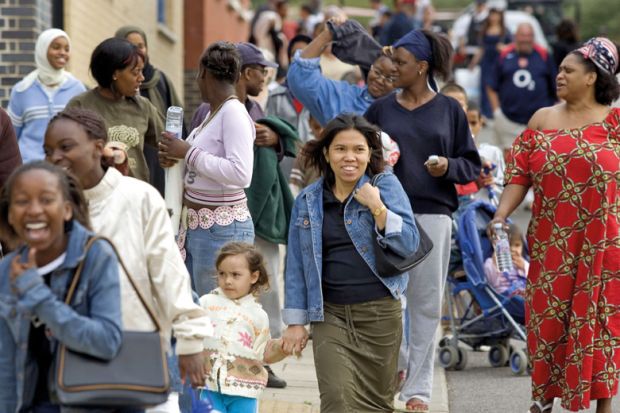Even since the start of this year, two major new books have been published with the single-word title Intersectionality. One by Patricia Hill Collins and Sirma Bilge has no subtitle and offers an overview of the field. The other, by Ange-Marie Hancock, is subtitled “an intellectual history”.
One of the pioneering papers in the field was published in 1991 by Kimberle Crenshaw, now a professor at both the UCLA School of Law and Columbia Law School. “Mapping the margins: intersectionality, identity politics, and violence against women of color” argued that “the violence that many women face is often shaped by other dimensions of their identity, such as race and class”, citing the case of immigrant women who were “wholly dependent on their husbands as their link to the world outside their homes” and sometimes for “information regarding their legal status”.
This has notable implications for policy that is designed to address domestic violence. But Professor Crenshaw also claimed that “racism as experienced by people of color who are of a particular gender – male – tend to determine the parameters of antiracist strategies, just as sexism as experienced by women who are of a particular race – white – tends to ground the women’s movement”. Only an intersectional approach can address the double bind of those suffering at the sharp end of both racism and sexism, she argued.
Although much writing about intersectionality has continued to focus on the interaction between race and gender, Professor Collins and Professor Bilge interpret its “core insight” as being that “major axes of social divisions in a given society, for example, race, class, gender, sexuality, dis/ability, and age operate not as discrete and mutually exclusive entities, but build on each other and work together”.
Yet they also cite the views of “two young white British cyberfeminists” that terms such as “intersectionality” end up alienating otherwise sympathetic people by “causing disagreements between those armed with an MA in Gender Studies and a large vocabulary to match, and those without”.
So how do scholars working in the field respond to such claims? Can intersectional approaches be used to improve policymaking? And where should intersectionality be located within the academy?
Ange-Marie Hancock, associate professor of political science and gender studies at the University of Southern California, is dismissive of the idea that terms such as “intersectionality” are alienating and academic (in the pejorative sense of the word), since “intersectionality-like thought” has been around for almost two centuries under “a variety of names that ordinary women gave it”.
Yet she sees it now as providing “a compelling analytical framework” and argues that it should “follow a path like neuroscience – [as] a fundamentally interdisciplinary specialty that eventually becomes a department or disciplinary field in its own right”.
For Sirma Bilge, professor of sociology at the University of Montreal, the question of whether intersectionality should be a distinct interdisciplinary field or a strand within existing disciplines such as sociology “needs to be tied to the question of who benefits from its being located in this or that place within the university structures.
"The academy is full of examples of ‘minority’ studies programmes that do not have a single professor of minority background…The issue for me is less where it is located than how it is located, whether or not by its location it can change the terms of the debate (how knowledge is produced, decentring dominant ways of doing sociology, or doing gender/women studies), rather than being yet another topic within the diversity portfolio of a given department.”
'Comfortable with complexity'
Angelia Wilson, professor of politics at the University of Manchester, is the editor of a book called Situating Intersectionality: Politics, Policy, and Power. She sees intersectionality as a perspective that “gives us the possibility to be comfortable with complexity”, and tries to “think across racial and cultural divides” even when looking at the impact of policy on gays and lesbians. Her book Why Europe Is Lesbian and Gay Friendly (and Why America Never Will Be), for example, drills down below broad pan-continental factors such as the European Court of Justice and pressure from activists to focus instead, for example, on religious traditions and “the understanding of welfare” in different countries.
In formulating policies designed to secure equal treatment for all citizens, Professor Wilson also sees an essential role for intersectional analyses looking at how initiatives “work in people’s actual lives. The point is to keep the focus on power, and our potential to affect different lives in different ways.”
Professor Hancock recalls an incident in her own life, not long after 9/11, when she was stared at in the grocery store and her mother asked, “Oh, do you think it was because they think you are Arab, or do you think it is just because you’re a professional woman of colour?”
Yet her response to such questions, she said, is “does it matter whether it is due to a singular or a multiple identity? The point, the thing that needed to be addressed, was the experience of the microaggression. Improving our ability to really examine the mechanisms of prejudice, stereotyping and prejudice does not, in my mind, logically require us to conceptualise the world as a place to be decomposed into its parts.”
It is precisely here, Professor Hancock believes, that intersectionality can help to spur a major intellectual transformation: “We still think in decomposition mode (that is, systems or people are the sum of their mutually distinct parts) rather than thinking in a more holographic mode (which requires us to grapple with how we might engage with the fundamental idea that we aren’t our gender Monday-Wednesday-Friday and our race/ethnicity Tuesday-Thursday-Saturday).
"One of intersectionality’s overlooked intellectual projects requires us to think of individuals, peoples and systems as if they were holograms – meaning they cannot be decomposed into their ‘ethnic part’ versus their ‘gender part’ versus their ‘class part’.”
The implications of this, Professor Hancock acknowledges, require “academics and activists to think very differently”, and that is precisely why intersectionality is “both the most exciting and the most misunderstood theory in the world right now”.
POSTSCRIPT:
Print headline: ‘The most exciting theory in the world’
Register to continue
Why register?
- Registration is free and only takes a moment
- Once registered, you can read 3 articles a month
- Sign up for our newsletter
Subscribe
Or subscribe for unlimited access to:
- Unlimited access to news, views, insights & reviews
- Digital editions
- Digital access to THE’s university and college rankings analysis
Already registered or a current subscriber? Login








